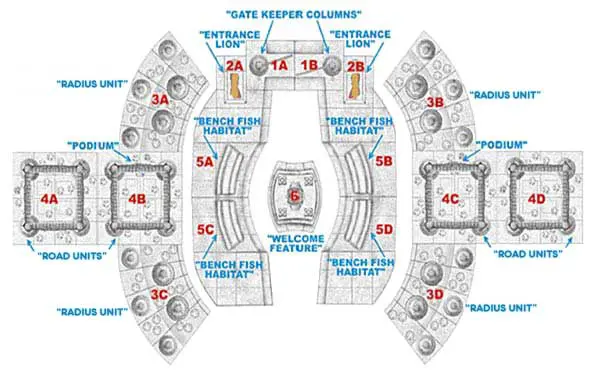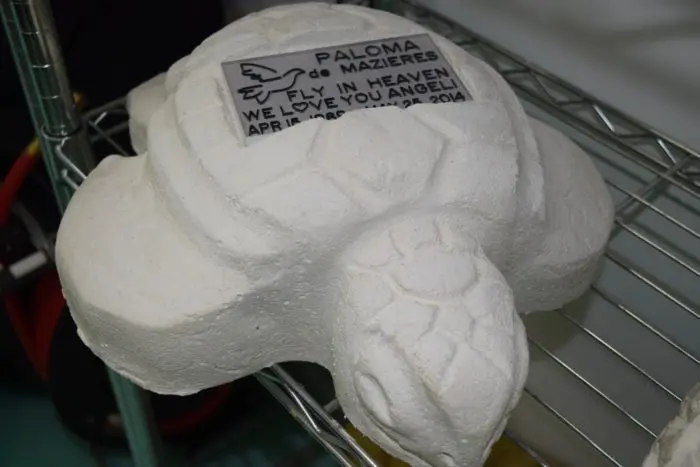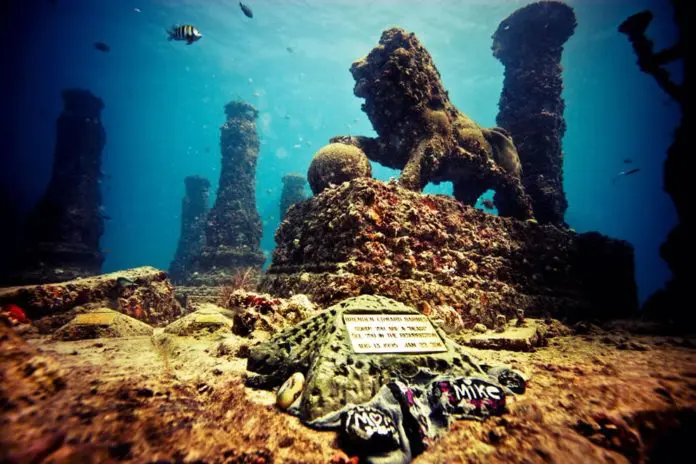Neptune Memorial Reef Located about 3 miles off the coast of Miami Florida is a truly unique artificial reef project. It does share some key points with other artificial reef projects around the world. The reef is being built on a sandy patch of the sea in about 40 feet of water, in this case, sand deposited that was eroded from the beaches further north. It has statues and other pieces of art similar in concept with other underwater art museums. The Neptune Memorial Reef is based on the concept of a lost sunken city which is also something being done elsewhere. However, the undersea structures here will cover 16 acres when completed. This will make it the largest artificial reef in the world. The local government is allocating an adjacent 16 acres if the need arises. Another unique point is that it is located near very deep water, which means that as it grows it will take on the traits of a barrier reef. It will be providing protection for the cays behind them and the coastal shore lines. What really makes this different it is the first cemetery planned to be underwater.
The Neptune Memorial Reef has been designed to hold the cremated remains of those who love the sea. While the initial plans have been in progress since 2007, the program is now starting to grow momentum. A Time magazine article earlier this year about the rise in popularity in cremation in the United States showed that it went from 10% in 1980 to just shy of 50% in 2015. Many countries in the world are much higher with Japan which has accepted cremation for centuries being the highest with 95%. How cremated remains are handled afterward is varied. Having ashes spread at sea has always been popular even a romantic means of honoring someone. Or placed in a favorite garden. To many those methods mentioned are not acceptable as they want something permanent. Some families will have the remains in an urn that is placed in a place of honor in the home and many cemeteries now have a Columbarium. This is a building or in some cases a wall with individual spaces to hold an urn. It is then closed and a memorial plaque is added. The structures of the Neptune Memorial Reef serve the same function as a columbarium with a slight modification.

Most of the footprint of the site is in place as well as many of the features. Details will be added in phases. The first phase included the area around the entrance gate and the center. The second phase is underway with the additional structures under construction and a planned deployment in the spring of 2017. There are a number of choices available for those who wish to become a part of the reef. The columns have places for cylinders to be placed, the fences have pickets, and there are marine placements. The columns are created and put in place with a number of 8-inch steel pipes placed inside. When the cremated remains of a person arrive, they will be securely stored until it is time to create the memorial. Portland cement is mixed with sand and then the remains are added to the mixture. It is then poured into a mold. When solid the mold is removed and the cylinder is allowed to naturally cure. When the process is complete, a date of placement is arranged with the family. The family travels to the reef, a brief service is held and scuba divers take the remains to the destination location. They remove a covering over the hole in the structure and insert the cylinder made from the remains into the whole. They replace the covering and place a memorial marking in the proper location. Any relative who are divers is welcome to participate in the placement. Many family members will choose to watch the activities while snorkeling at the surface. An additional service provided is a memorial website page similar to those offer by a funeral home. The page has an obituary, a place for photographs and a guest book. The exact location of the marker is shown as well as a photograph of the marker in place.

The marine placements are done in a manner similar to the cylinders. The placements are made in the same way, however, when placed they are placed on the base of the structures. Currently, over 500 individuals have had their remains placed at the site, and another 500 have purchased locations as pre-need. That leaves about 500 spaces in the first phase. the second phase will also have space for 1,500 people. In total, the entire site could exceed 200,000.
Diving the Neptune Memorial Reef
When I meet with Jim Hutslar the Operations director of the project, we talked about the different processes that had to occur to get the project started. The overall designed had to meet a number of different federal and local regulations. The first hurdle was that the structure had to be done in a manner that withstands cat 5 hurricanes. Then the marine biologist had their say to ensure that the design would attract marine life and provide a safe haven for juvenile fish. Finally, everyone was satisfied and the hard work started. Since the beginning of the project, the site has been monitored by marine scientist tracking the progress and studying the results. Local universities with marine science departments have used the site as a field study, measuring growth rates and counting the species that have become part of the local habitat.
A 2012 survey showed 195 coral colonies were identified and 14 species, 5 more species of coral than the year before. 56 different species of fish have been identified, the most abundant being the Bluehead Wrasse. Sergeant Majors, Bar Jacks, and Tomtates are also present in substantial numbers. Fish diversity at the site appears to be increasing. Many species of crab and the long-spined sea urchin are found in crevices, including one sea urchin previously believed to extinct in the Caribbean Sea. The rate of growth of the corals and the increase in the number and variety of other marine life is at a pace faster than expected and far better than any other artificial reef project in Florida.
Miami, itself, does not have many dive centers. Most divers go a few miles north to Fort Lauderdale or south to Key Largo. However, the three dive centers that are in Miami visit the Neptune Memorial Reef weekly. The dive center generally does two dives on the reef. While there may be currents at times, the shallow depth of the reef does make it available for open water divers.
My family has known for some time of my desire to be cremated when my time comes. Now I believe I know where I want to go. Prices for a placement here range from $1,999 to a few places at $5,999. This is much less than a cemetery plot for burial, not even counting the coffin. It is also in line or less than what a columbarium would be above water. The Neptune Memorial Reef website has more information.

